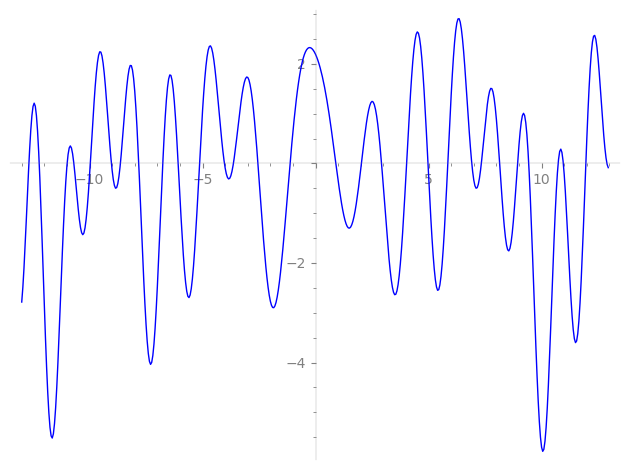| L(s) = 1 | + (0.745 + 1.29i)3-s + (−0.143 + 0.248i)5-s + (0.388 − 0.673i)9-s + (−0.5 − 0.866i)11-s + 3.49·13-s − 0.427·15-s + (0.888 + 1.53i)17-s + (−3.31 + 5.74i)19-s + (4.30 − 7.45i)23-s + (2.45 + 4.25i)25-s + 5.63·27-s − 3.69·29-s + (−0.929 − 1.61i)31-s + (0.745 − 1.29i)33-s + (−3.71 + 6.43i)37-s + ⋯ |
| L(s) = 1 | + (0.430 + 0.745i)3-s + (−0.0640 + 0.110i)5-s + (0.129 − 0.224i)9-s + (−0.150 − 0.261i)11-s + 0.968·13-s − 0.110·15-s + (0.215 + 0.373i)17-s + (−0.760 + 1.31i)19-s + (0.897 − 1.55i)23-s + (0.491 + 0.851i)25-s + 1.08·27-s − 0.686·29-s + (−0.166 − 0.289i)31-s + (0.129 − 0.224i)33-s + (−0.610 + 1.05i)37-s + ⋯ |
\[\begin{aligned}\Lambda(s)=\mathstrut & 2156 ^{s/2} \, \Gamma_{\C}(s) \, L(s)\cr =\mathstrut & (0.605 - 0.795i)\, \overline{\Lambda}(2-s) \end{aligned}\]
\[\begin{aligned}\Lambda(s)=\mathstrut & 2156 ^{s/2} \, \Gamma_{\C}(s+1/2) \, L(s)\cr =\mathstrut & (0.605 - 0.795i)\, \overline{\Lambda}(1-s) \end{aligned}\]
Particular Values
| \(L(1)\) |
\(\approx\) |
\(2.192006681\) |
| \(L(\frac12)\) |
\(\approx\) |
\(2.192006681\) |
| \(L(\frac{3}{2})\) |
|
not available |
| \(L(1)\) |
|
not available |
\(L(s) = \displaystyle \prod_{p} F_p(p^{-s})^{-1} \)
| $p$ | $F_p(T)$ |
|---|
| bad | 2 | \( 1 \) |
| 7 | \( 1 \) |
| 11 | \( 1 + (0.5 + 0.866i)T \) |
| good | 3 | \( 1 + (-0.745 - 1.29i)T + (-1.5 + 2.59i)T^{2} \) |
| 5 | \( 1 + (0.143 - 0.248i)T + (-2.5 - 4.33i)T^{2} \) |
| 13 | \( 1 - 3.49T + 13T^{2} \) |
| 17 | \( 1 + (-0.888 - 1.53i)T + (-8.5 + 14.7i)T^{2} \) |
| 19 | \( 1 + (3.31 - 5.74i)T + (-9.5 - 16.4i)T^{2} \) |
| 23 | \( 1 + (-4.30 + 7.45i)T + (-11.5 - 19.9i)T^{2} \) |
| 29 | \( 1 + 3.69T + 29T^{2} \) |
| 31 | \( 1 + (0.929 + 1.61i)T + (-15.5 + 26.8i)T^{2} \) |
| 37 | \( 1 + (3.71 - 6.43i)T + (-18.5 - 32.0i)T^{2} \) |
| 41 | \( 1 - 2.63T + 41T^{2} \) |
| 43 | \( 1 - 10.8T + 43T^{2} \) |
| 47 | \( 1 + (-3.80 + 6.59i)T + (-23.5 - 40.7i)T^{2} \) |
| 53 | \( 1 + (-3.74 - 6.48i)T + (-26.5 + 45.8i)T^{2} \) |
| 59 | \( 1 + (1.18 + 2.04i)T + (-29.5 + 51.0i)T^{2} \) |
| 61 | \( 1 + (-0.777 + 1.34i)T + (-30.5 - 52.8i)T^{2} \) |
| 67 | \( 1 + (-3.06 - 5.30i)T + (-33.5 + 58.0i)T^{2} \) |
| 71 | \( 1 - 12.3T + 71T^{2} \) |
| 73 | \( 1 + (4.22 + 7.32i)T + (-36.5 + 63.2i)T^{2} \) |
| 79 | \( 1 + (5.19 - 9.00i)T + (-39.5 - 68.4i)T^{2} \) |
| 83 | \( 1 - 16.1T + 83T^{2} \) |
| 89 | \( 1 + (5.07 - 8.78i)T + (-44.5 - 77.0i)T^{2} \) |
| 97 | \( 1 + 3.04T + 97T^{2} \) |
| show more | |
| show less | |
\(L(s) = \displaystyle\prod_p \ \prod_{j=1}^{2} (1 - \alpha_{j,p}\, p^{-s})^{-1}\)
Imaginary part of the first few zeros on the critical line
−9.031099679061995567122273834672, −8.634912207049448603285719492610, −7.82370113428786796431916357260, −6.75908335428544575524951507384, −6.07949966050692073953104190288, −5.13273694372591195573740056322, −4.03133136459388203692406806936, −3.63523863383531771272531888733, −2.55016488420970791854709884305, −1.12719780439860937846809437490,
0.897313461498310835397461390271, 2.02770768318810113822592891043, 2.91856478962940254689323911274, 4.02733019560046309112881828178, 4.97318668638586084925258972511, 5.85023277080017860111651936808, 6.91219402029171663398604493671, 7.33366980426173966110976837578, 8.144732238655207927923640862960, 8.937967225989063244729861200365

